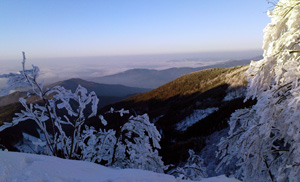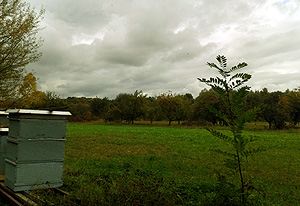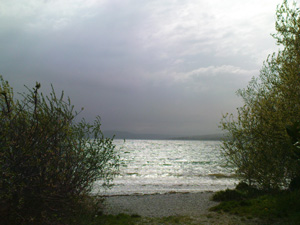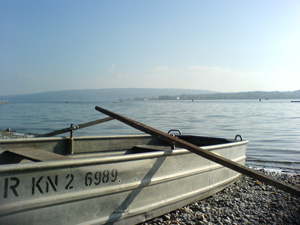|
ETHICAL
JEWELLERY COLLECTIONS MAIN MENU » THE
SOUTHERN BLACK FOREST / THREE-COUNTRY CORNER COLLECTIONS »
ABOUT THE CONSERVATION AREAS
The
Southern Black Forest, Lake Constance, The Rhine and Three-Country
Corner

From the Black Forest mountains overlooking
the Rhine Valley towards France
Southern
Black Forest, Switzerland and Eastern France (Alsace)
In the higher lakes
and rivers of the Southern Black Forest there are also environmentally
sensitive areas where conservation projects are trying to protect
threatened species, some of which are on the "Red List".
Atelier Laibach in Germany is situated close to two other countries,
therefore Switzerland and the Alsace region of France are covered
by our gathering principles.
The Tri-National Environmental Centre (Trinationale Umweltzentrum
or TRUZ), founded in 1998, is based in Weil am Rhein near Basel
and is a key organisation uniting local ecological concerns from
within the three bordering countries. The organisation's project,
called Regiobogen helps to create wetlands, monitor wildlife and
re-nature these cross-border environments around the Rhine Valley
which are increasingly overwhelmed by industry and population
growth. Surrounding the headquaters of TRUZ on the Swiss / German
border it is possible to see their conservation work in action.
They are re-naturing a large area of land which was formerly a
huge extraction area of stones from the Rhine and Wiese rivers.
Stones were extracted to a depth of around 30 metres leaving a
baron industrial "desert".The picture below shows one
of TRUZ's recently created ponds in front one of the remaining
hills of shingle, giving a graphic example of how high the original
elevation of the entire area was.

A recently created pond at the Truz
headquaters nature reserve
The sale of pieces
made by Kerstin Laibach based on stones gathered in this region,
plus wedding and partnership rings made for local couples, directly
benefits this important re-naturing work of Truz. Re-naturing
plays a vital role in combating the damage caused to the Earth
by the extraction industry (most notably the unnecessary mining
of gold).
External Link to
TRUZ (in German and
French only)

Overlooking a re-nature area of the
TRUZ reserve with beehives
Lake
Constance
Lake Constance is also regionally
known as Bodensee and lies just north of the Alps. This border
lake covers over 500 square kilometres, with Germany owning 173km
of shore-line, Switzerland 72 km and Austria 28 km. The Principality
of Liechtenstein also has a share of the lake's resources.
Lake Constance is mainly made up by the water of the Rhine river
which enters the lake between Hard and Bregenz and exits at Stein
am Rhein. After Lake Geneva, Constance is the second largest pre-Alpine
lake, but more significantly it is one of the most important habitats
for plants and wildlife in Europe (up to 412 species of birds
due to its location as Europe's main migratory route).

Lake Constance (Bodensee)
BACKGROUND
In recent years the ecology
of Lake Constance has suffered serious damage, due to largely
un-regulated spread of structural development and tourism; mostly
attributed to its ever-growing popularity as one of the most attractive
places to live. In comparison to the size of the lake and its
surroundings, the conservation areas of Bodensee are tiny, with
environmental and wildlife protection in and around the lake low
on the list of priorities with local authorities.
From the 19th century, nature around
Bodensee has been under attack from development, which also meant
the clearing of huge areas of woodland. Over the years, pollution
has caused serious damage to the lakes ecology and what is left
of the natural lakeland today are just a few protected areas.
The biggest of these is the Rhinedelta (mainly in Austria and
Switzerland). There is also the Eriskircher Ried and the Wollmatinger
Ried, which are only open to the public when accompanied by official
guides at certain times of the year. The Wollmatinger Reid is
the oldest and most important breeding area on the German side
of the lake. The Eriskircher Ried is the largest protected area
on the north shore. These remaining marshlands and reed banks
play host to threatened wildlife and plants ...once abundant throughout
the entire region. The protected parts of the lake shores are
home to very rare plants such as Sibirische Schwertlilie, along
with a variety of orchids. The Rhinedelta part of Lake Constance
has around 20 square kilometres of surrounding wetlands and is
the most important stopping point on the lake for migratory and
transitory birds.

Overlooking Lake Constance (Bodensee)
TODAY'S THREAT
Although the 19th century had such
a devastating environmental impact on the lake, it wasn't until
1959 that an international water safety commission (IGKB) was
established to help avoid further polluting. However, even up
until the 1970's the river Rhine had been notorious for being
one of the most polluted rivers in Europe. Today, the water in
Lake Constance may be cleaner than in the recent past but the
threats to its surviving ecology are perhaps even more serious
than ever. Besides the encroachment of housing developments, the
local fishing industry is at war with Bodensee bird life. The
lake is uniquely home to the Bodensee Felchen fish - a local speciality.
But in an attempt to pass the blame to nature, there are claims
that birds are eating through the lake's fish stock. Cormorants
have now seriously suffered due to a heavy culling at the request
of fishermen. Like in many seas and lakes around the world, fishing
industries say that either birds or our sea mammals are responsible
for depleted fish numbers. However, the truth is that excessive
harvesting by humans has caused the problem.
The concerns of wildlife
protection groups are too often ignored by local developers, tourism
and the fishing industry which continues to disrupt the fragile
ecology of Lake Constance. Environmentalists say that there should
also be much more focus on protecting the few remaining green
areas being swallowed up by development. Habitats, between sprawling
housing developments, should be preserved to enable wildlife to
at least have a chance to coexist with human inhabitants. On a
positive note, support from the EU and Switzerland means that
Bodensee storks are continuing to survive amongst growing housing
developments. Some meadowlands are maintained to assist their
breeding and survival, and their huge nests can be seen on tops
of high tree stumps in some back gardens. Over twenty nests are
currently in place and the numbers are growing. The sale of pieces
made by Kerstin Laibach based on stones gathered in this region,
plus wedding and partnership rings made for local couples, directly
benefits re-naturing and protection work overseen by Bodensee
Stiftung (International Foundation for Nature and Culture).
External
Link to Bodensee Stiftung
How
Laibach Helps
When you buy a Laibach piece, fifteen percent of the profit is
awarded to the few conservation / wildlife protection organisation
in areas of Lake Constance, the Southern Black Forest and the
Rhine region, often near where the main stone(s) in your piece
were gathered. If a piece does not include stones, fifteen percent
of profits is placed into a general fund and distributed evenly
to qualifying conservation and wildlife projects relative to Laibach
creations. Laibach also aims to support the few independent protection
organisations in other areas of Southern Germany, Switzerland
and Eastern France through a percentage of profits from pieces
which include stones gathered from nearby. Please see more about
Kerstin Laibach's wildlife and environmental commitments here.
Please revisit these
pages for updates on Laibach collections which contribute to causes
in these areas.
Back
to The Lake Constance Collection Main Page
Laibach's
commitment to wildlife and the environment
Information
on the Laibach gathering area of South and West England
Information
on Laibach donations to Gorongosa National Park, Africa

Lake Constance (Bodensee) from Mettnau
|